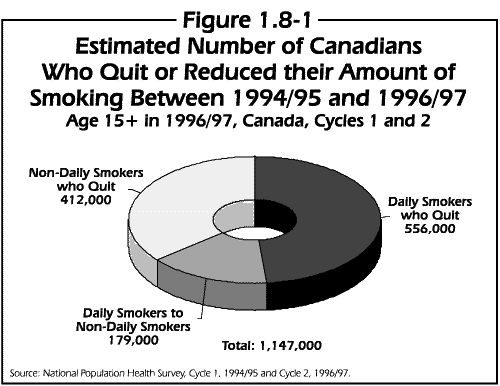Centre for Chronic Disease Prevention and Control
Cancer

Smoking Behaviour of Canadians
Cycle 2, 1996/97 (January 1999, No. 1)
Who is Quitting and Why?
The longitudinal design of the National Population Health Survey (NPHS) allows for
changes in the smoking behaviour of individuals to be followed over time. This Highlights report focuses
on changes in the smoking status of individuals from when they were first surveyed in 1994/95 (Cycle 1) to when
they were surveyed again in 1996/97 (Cycle 2). All ages reported in this summary refer to the age of the individuals
when they were surveyed in 1996/97, and the analyses in this report are restricted to those 15 and older in 1996/97.
Who is Quitting?
In 1994/95, over 5.8 million Canadians (who were 15 and over in 1996/97) smoked
every day. By 1996/97, approximately 556,000 of these smokers had quit (representing 10% of daily smokers) and
about 179,000 (or 3% of daily smokers) had reduced their smoking to only occasionally (Figure 1.8-1).

In 1994/95, just over 1.1 million Canadians (who were 15 and over in 1996/97)
were occasional smokers. By 1996/97, 35% of these occasional smokers (representing approximately 412,000 Canadians)
had quit smoking. The total of 968,000 daily and occasional smokers who quit were replaced by 947,000 brand new
smokers and relapsed quitters.
When males and females aged 15 and over were compared, 11% of females who had
been smoking daily two years before had quit by 1996/97, and a further 4% had cut back to occasional smoking. Among
males, 9% had quit completely by 1996/97, and a further 3% had reduced to occasional smoking.
Among those females who smoked only occasionally in 1994/95, 40% had quit by
1996/97, whereas 32% of males had quit within the two years. This quit rate among occasional smokers is tempered
by the observation that 32% of occasional smoking females and 35% of occasional smoking males actually became daily
smokers between 1994/95 and 1996/97.
Who Intends to Quit?
Of the smokers in 1994/95 who were still smoking in 1996/97, 46% were considering
quitting within six months. Of those who were former smokers in 1994/95 but had started smoking again by 1996/97,
59% intended to quit within six months. Of the new smokers, 45% intended to quit.
Why Do Smokers Quit or Cut Down on Smoking?
When respondents who had quit smoking since they were first interviewed in 1994/95
were asked their main reason for quitting, by far the most common reason cited was concerns about the effects of
smoking on their physical health. Overall, 49% of males and 45% of females gave this as their reason for quitting.
Other main reasons mentioned by some who had quit included cost, pressure from family/friends, and pregnancy (for
female smokers).
The principal reason cited by people for cutting down on smoking was that
they were trying to quit (39%). The next most common reason given for cutting down was that smoking affected their
physical health in some way (23%). Pregnancy also emerged as a main reason among females for cutting down on the
amount smoked. Small sample sizes precluded further detail.
Who is Relapsing?
As one might expect, there were more former smokers among older age groups (ranging
from 19% for those under 25 in 1996/97 to 40% of Canadians 55 and over). Older former smokers were much less likely
to have relapsed (i.e., resumed smoking between 1994/95 and 1996/97) than younger former smokers. Only 5% of former
smokers over the age of 34 resumed smoking between 1994/95 and 1996/97, compared with 34% of former smokers under
25. Younger former daily smokers were more likely to relapse than younger former occasional smokers (43% vs. 32%
respectively for those under 25). This pattern was not observed among older former smokers, which is probably because
former daily smokers had quit for longer periods of time. There was no obvious sex difference in the percentage
of former daily smokers and former occasional smokers who resumed smoking within each age group.
What is happening nationally regarding smoking prevalence?
Between 1994/95 and 1996/97, 968,000 Canadians aged 15 and over (in 1996/97)
quit smoking. Those who quit were replaced by 947,000 Canadians who became current smokers for the first time or
resumed smoking between 1994/95 and 1996/97.
|
Terminology
- Current smoker - was smoking at the time of the interview, and includes
daily smokers and non-daily smokers (also known as occasional smokers). Smoking status was determined
from the response to the question: "At the present time do you smoke cigarettes daily, occasionally or not at all?"
- Former smoker - was not smoking at the time of the interview, however
answered "YES" to the question: "Have you ever smoked cigarettes at all?" Former daily smokers and former
occasional smokers were then determined by their response to the question: "Have you ever smoked cigarettes
daily?". In Cycle 2, time since quitting was not collected.
- Never smoker - was not smoking at the time of the interview and answered
"NO" to the question: "Have you ever smoked cigarettes at all?"
- Non-smokers - are former smokers and never smokers, combined.
- Prevalence of smoking - the proportion of cigarette smokers in the specified
population.
- Amount smoked - the number of cigarettes smoked per day for daily smokers
only.
- Quitters - those individuals who classified themselves as either "daily"
or "occasional" smokers in 1994/95, and then as "former smokers" in 1996/97.
- Environmental tobacco smoke (ETS) - also known as second-hand smoke.
Exposure to ETS was determined from the response to the question: "Does anyone in this household smoke regularly
inside the house?"
|
|
![]()





